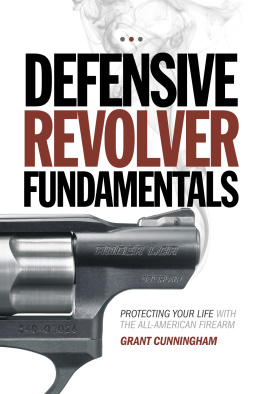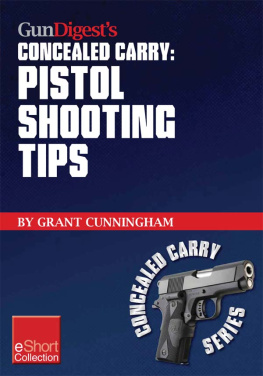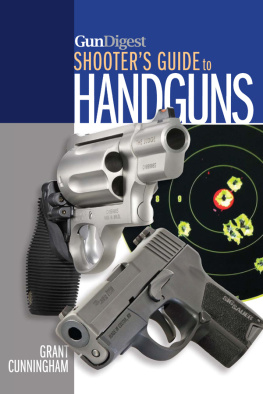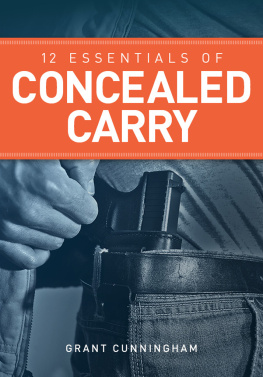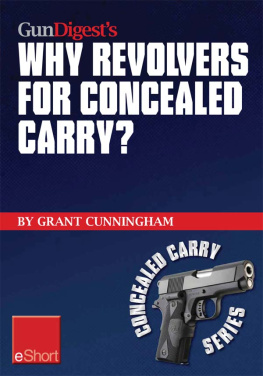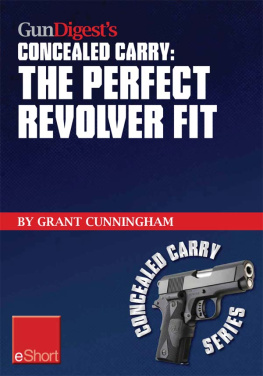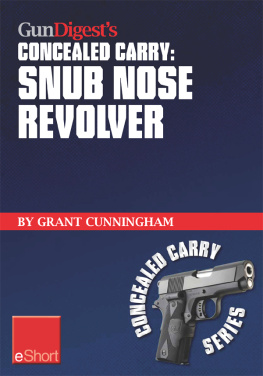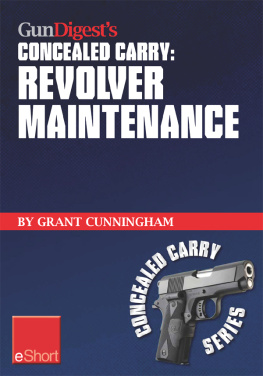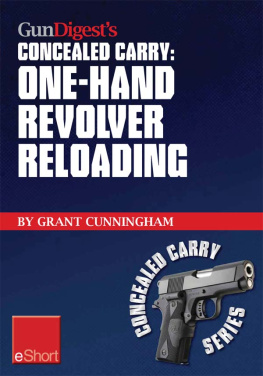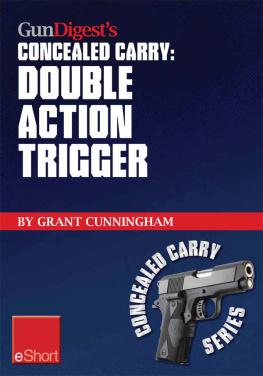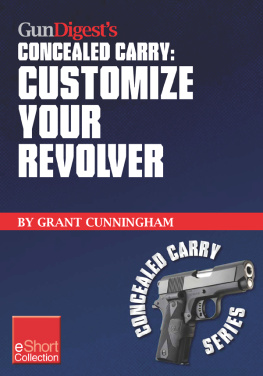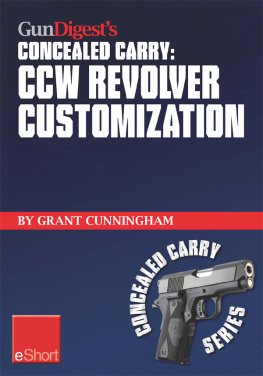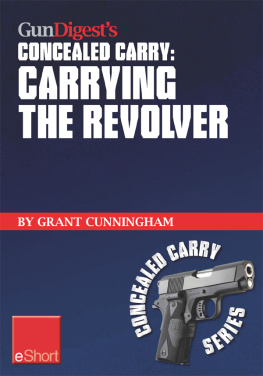Grant Cunningham - Gun Digests Speed Reloading the Revolver Concealed Carry eShort
Here you can read online Grant Cunningham - Gun Digests Speed Reloading the Revolver Concealed Carry eShort full text of the book (entire story) in english for free. Download pdf and epub, get meaning, cover and reviews about this ebook. year: 2012, publisher: F+W Media, genre: Home and family. Description of the work, (preface) as well as reviews are available. Best literature library LitArk.com created for fans of good reading and offers a wide selection of genres:
Romance novel
Science fiction
Adventure
Detective
Science
History
Home and family
Prose
Art
Politics
Computer
Non-fiction
Religion
Business
Children
Humor
Choose a favorite category and find really read worthwhile books. Enjoy immersion in the world of imagination, feel the emotions of the characters or learn something new for yourself, make an fascinating discovery.
- Book:Gun Digests Speed Reloading the Revolver Concealed Carry eShort
- Author:
- Publisher:F+W Media
- Genre:
- Year:2012
- Rating:4 / 5
- Favourites:Add to favourites
- Your mark:
- 80
- 1
- 2
- 3
- 4
- 5
Gun Digests Speed Reloading the Revolver Concealed Carry eShort: summary, description and annotation
We offer to read an annotation, description, summary or preface (depends on what the author of the book "Gun Digests Speed Reloading the Revolver Concealed Carry eShort" wrote himself). If you haven't found the necessary information about the book — write in the comments, we will try to find it.
In this excerpt from the Gun Digest Book of the Revolver, Grant Cunningham teaches you the defensive reload, tactical reload, competition reload and other techniques to keep your sixgun running. Also covered are speed loaders and moon clips.
Gun Digests Speed Reloading the Revolver Concealed Carry eShort — read online for free the complete book (whole text) full work
Below is the text of the book, divided by pages. System saving the place of the last page read, allows you to conveniently read the book "Gun Digests Speed Reloading the Revolver Concealed Carry eShort" online for free, without having to search again every time where you left off. Put a bookmark, and you can go to the page where you finished reading at any time.
Font size:
Interval:
Bookmark:

Flatten your right hand and swiftly strike the ejector rod one time with your palm. This accelerates the brass and tends to throw it clear of the cylinder, even with short ejector rods. Velocity is more important than force, and its important that you only strike the ejector rod one time. If there are any cases that fail to clear the cylinder, multiple ejections will not clear them but do significantly raise the risk of a case-under-extractor jam. This technique virtually eliminates the risk of such a jam. If there are cases that dont clear, you can pick them out without danger of a jam.
One of the major criticisms of the double action revolver is that its hard to reload efficiently. With an autoloading pistol the empty magazine is ejected and the replacement rounds are contained in a large, easy to handle package that goes into the gun in one smooth motion. The revolver, on the other hand, has to be partially disassembled, the old cases ejected, the new rounds inserted into their individual holes, and then the gun reassembled. Its a tedious task, of that there is no doubt!
Its also a time-consuming job that requires a large amount of manual dexterity to perform. Reloading the revolver efficiently, especially under stress, is not the easiest task in the world. That doesnt mean its impossible, nor does it mean that it cant be done efficiently. There are ways to make the revolver reload easier and faster, and thats what this chapter is all about.
The worst case scenario for reloading the revolver in a timely manner has to be during self-defense. Since my personal shooting interest these days is primarily for self-defense, the reload techniques I use are optimized for the demands of that situation. Those demands are very different than those of pure competition; as youll see, more efficient does not always mean faster.
Circumstances that affect our technique
Why focus on the defensive reload? Because the self-defense incident is the most demanding of the very things that are required to get the wheelgun up and operating: fine motor skills. They are greatly hampered or diminished during a defensive encounter, and they make efficient revolver reloads more difficult.
Ideally wed have a reload technique that doesnt require any fine motor coordination at all, but thats not a practical goal. The revolver by its very design requires close interaction with our fingers, just at a time when the strength, dexterity, and tactile sensation of those digits is compromised by the event. We cant eliminate the requirement for fine motor skills because the demands of the guns design wont let us.
That doesnt mean that we cant seek to minimize dependence on those fine skills as much as possible. The less we rely on small muscle groups and precise control, the more chances for error we eliminate. Thats why an ideal defensive reloading technique minimizes, to the greatest degree possible, the reliance on fine motor movements and dexterity. Again, we cant eliminate them entirely because we still have to interact with a mechanical device, but the more we reduce our reliance on those skills the more efficient well be.
Proponents of competition-based techniques arent fond of this approach, pointing out that operating the trigger is a fine motor skill as well and we dont worry about that! While largely true, the trigger finger action is still relatively primitive (a simple grasp) compared to the subtle manipulations required to put rounds into the cylinders chambers. Its also something that we cant work around.
We can work around the manipulations used in reloading. By focusing on large muscle groups and coarse motor movements whenever possible, we make the revolver reload more stress resistant, less prone to failure, and more efficient under the worst conditions.
The defensive reload is fast, but its main benefit is that its designed to work with the bodys natural reactions in a life-or-death struggle. By minimizing the need for fine motor control and dexterity, a good defensive reload makes it far less likely that the shooter is going to stall the reload and prolong his or her exposure to danger. It can certainly be used competitively, and many people do, me included.
A serious competition shooter, however, may desire a different technique optimized for that job. By relying more on fine motor skills and weak hand manipulation, its possible to make the reload process just a bit faster. Doing this means that the reload technique has a few more points of possible failure, but because competition doesnt have the same deleterious effect on motor control and coordination as a violent attack, the reload technique can cut many corners and still be viable. If you flub a reload in a match, youre out nothing but pride.
The reverse is not true, because the demands on motor control and concentration in a defensive encounter can lead to a botched reload, and a botched reload can lead to serious consequences. For this reason I recommend that you use the defense-oriented Universal Revolver Reload technique if you carry a revolver primarily for self-defense. If youre primarily a competitor, and you have a properly equipped gun, youll be able to shave a few tenths of a second off your time by using the slightly faster Competition Reload.
The choice is yours, and I hope Ive laid out the criteria for your decision.
In addition, Ill show you a defensive reload technique for left-handed shooters. In a later chapter youll also see techniques for one-handed reloads, both strong and weak hand.
If youve been around the revolver world for very long, youve probably noticed that there is a wide range of opinion on, and variety in, revolver reload techniques. You can find people who will argue incessantly about the best way to perform a reload. I respect others opinions, but I believe these techniques to be the best in class for the reasons youll see.

Using the palm of your left hand, strike the ejector rod once only.
Defensive reloading: the Universal Revolver Reload
As I mentioned, its possible to mess up a revolver reload, particularly under threatening stress. There are a couple of points in the process where a reload can be significantly delayed or even completely stalled improper technique or ignorance of the dynamics involved. The Universal Revolver Reload, or URR, is designed to avoid those failure points to the greatest degree possible.
One failure point occurs during the ejection of spent casings. If the stroke of the ejector is longer than the case of the rounds being shot, its easy to end up with the dreaded case-under-extractor jam. Another failure point occurs during insertion of a speedloader, where its not uncommon for a live round to bind in the loader and prevent the cylinder from closing.
The URR is designed specifically to prevent both of these. By reducing the reliance on fine motor control, the URR minimizes these stress-induced failure points during the reloading process. Its as fast as most other techniques, but I believe it to be more reliable when the hands experience the bodys natural reactions to a threat stimulus: lowered strength, flexibility, and feeling in the extremities.

As the cylinder unlatches, the fingers of your left hand will naturally apply pressure to open the cylinder. Remember that its the movement of the gun against your fingers that does the work. As the muzzle comes to the vertical position, just let the gun rotate onto the middle fingers of your left hand, thus pushing the cylinder fully open. Grasp the cylinder between your thumb and fingers to immobilize it, and remove your right hand from the grip. The gun will now be hanging vertically on the left hand fingers. Up to this point youve used primarily large muscle groups and gross motor movements, which are very resistant to degradation during the bodys natural response to a threat.
Font size:
Interval:
Bookmark:
Similar books «Gun Digests Speed Reloading the Revolver Concealed Carry eShort»
Look at similar books to Gun Digests Speed Reloading the Revolver Concealed Carry eShort. We have selected literature similar in name and meaning in the hope of providing readers with more options to find new, interesting, not yet read works.
Discussion, reviews of the book Gun Digests Speed Reloading the Revolver Concealed Carry eShort and just readers' own opinions. Leave your comments, write what you think about the work, its meaning or the main characters. Specify what exactly you liked and what you didn't like, and why you think so.



